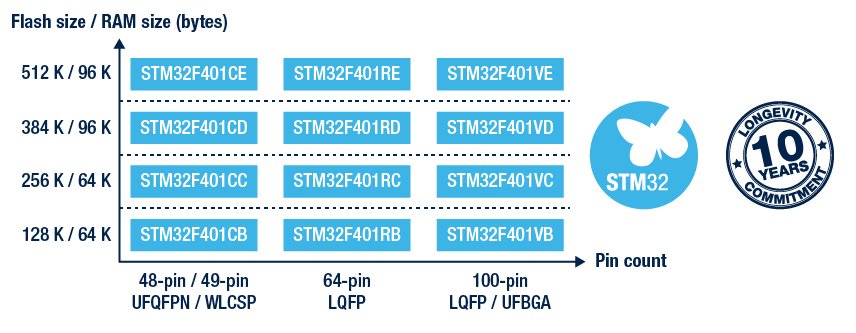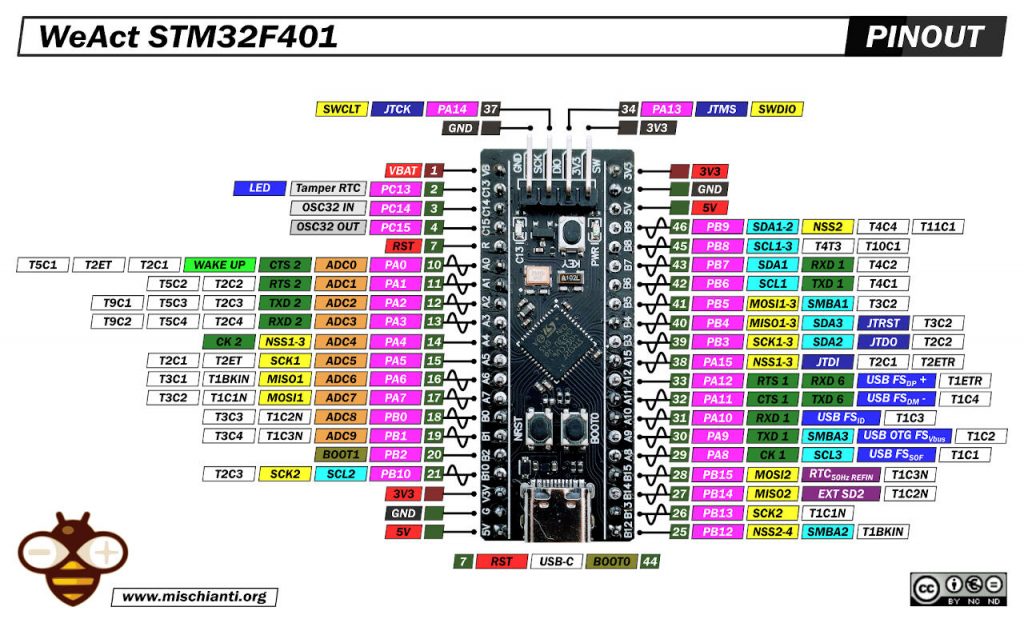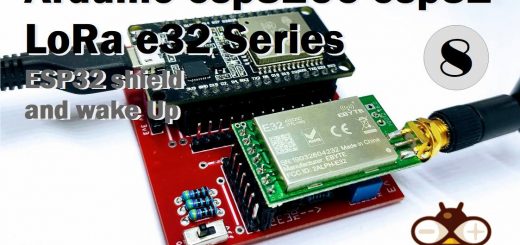WeAct STM32F401CCU6 Black-Pill: high-resolution pinout and specs
Link to the high resolution pinout image
Here the most used STM32 boards STM32F103C8T6 STM32F401 STM32F411 ST-Link v2 ST-Link v2 official
Description
The STM32F401xB/STM32F401xC devices are based on the high-performance Arm® Cortex® -M4 32-bit RISC core operating at a frequency of up to 84 MHz. The Cortex®-M4 core features a Floating point unit (FPU) single precision which supports all Arm single-precision data-processing instructions and data types. It also implements a full set of DSP instructions and a memory protection unit (MPU) which enhances application security. The STM32F401xB/STM32F401xC incorporate high-speed embedded memories, and an extensive range of enhanced I/Os and peripherals connected to two APB buses, two AHB buses and a 32-bit multi-AHB bus matrix.

All devices offer one 12-bit ADC, a low-power RTC, six general-purpose 16-bit timers including one PWM timer for motor control, two general-purpose 32-bit timers. They also feature standard and advanced communication interfaces.
The STM32F401xB/STM32F401xC operate in the – 40 to + 125 °C temperature range from a 1.7 (PDR OFF) to 3.6 V power supply. A comprehensive set of power-saving mode allows the design of low-power applications.
These features make the STM32F401xB/STM32F401xC microcontrollers suitable for a wide range of applications. (from ST)
All STM32401 have pins 5v tolerant (green square in the pinout diagram)
This board type offers a socket to the bottom to add an External SPI Flash, and SPI1 CS/SCK/MISO/MOSI (PA4/PA5/PA6/PA7) are Routed to the footprint for external flash.
Specs
- Dynamic efficiency line with BAM (batch acquisition mode)
- 1.7 V to 3.6 V power supply
- -40 °C to 85/105/125 °C temperature range
- Core: Arm® 32-bit Cortex®-M4 CPU with FPU, Adaptive real-time accelerator (ART Accelerator™) allowing 0-wait state execution from Flash memory, frequency up to 84 MHz, memory protection unit, 105 DMIPS/1.25 DMIPS/MHz (Dhrystone 2.1), and DSP instructions
- Memories
- Up to 256 Kbytes of Flash memory
- 512 bytes of OTP memory
- Up to 64 Kbytes of SRAM
- Clock, reset and supply management
- 1.7 V to 3.6 V application supply and I/Os
- POR, PDR, PVD and BOR
- 4-to-26 MHz crystal oscillator
- Internal 16 MHz factory-trimmed RC
- 32 kHz oscillator for RTC with calibration
- Internal 32 kHz RC with calibration
- Power consumption
- Run: 128 μA/MHz (peripheral off)
- Stop (Flash in Stop mode, fast wakeup time): 42 μA typ @ 25 °C;65 μA max @25 °C
- Stop (Flash in Deep power down mode, slow wakeup time): down to 10 μA typ@ 25 °C; 28 μA max @25 °C
- Standby: 2.4 μA @25 °C / 1.7 V without RTC; 12 μA @85 °C @1.7 V
- VBAT supply for RTC: 1 μA @25 °C
- 1×12-bit, 2.4 MSPS A/D converter: up to 16 channels
- General-purpose DMA: 16-stream DMA controllers with FIFOs and burst support
- Up to 11 timers: up to six 16-bit, two 32-bit timers up to 84 MHz, each with up to 4 IC/OC/PWM or pulse counter and quadrature (incremental) encoder input, two watchdog timers (independent and window) and a SysTick timer
- Debug mode
- Serial wire debug (SWD) & JTAG interfaces
- Cortex®-M4 Embedded Trace Macrocell™
- Up to 81 I/O ports with interrupt capability
- All IO ports 5 V tolerant
- Up to 78 fast I/Os up to 42 MHz
- Up to 11 communication interfaces
- Up to 3 × I2C interfaces (1Mbit/s, SMBus/PMBus)
- Up to 3 USARTs (2 x 10.5 Mbit/s, 1 x 5.25 Mbit/s), ISO 7816 interface, LIN, IrDA, modem control)
- Up to 4 SPIs (up to 42 Mbits/s at fCPU= 84 MHz), SPI2 and SPI3 with muxed full-duplex I2S to achieve audio class accuracy via internal audio PLL or external clock
- SDIO interface
- Advanced connectivity
- USB 2.0 full-speed device/host/OTG controller with on-chip PHY
- CRC calculation unit
- 96-bit unique ID
- RTC: subsecond accuracy, hardware calendar
How to
- STM32F1 Blue-Pill: pinout, specs, and Arduino IDE configuration (STM32duino and STMicroelectronics)
- STM32: program (STM32F1) via USB with STM32duino bootloader
- STM32: programming (STM32F1 STM32F4) via USB with HID boot-loader
- STM32F4 Black-Pill: pinout, specs, and Arduino IDE configuration
- STM32: ethernet w5500 with plain HTTP and SSL (HTTPS)
- STM32: ethernet enc28j60 with plain HTTP and SSL (HTTPS)
- STM32: WiFiNINA with ESP32 WiFi Co-Processor
- How to use SD card with stm32 and SdFat library
- \STM32: SPI flash memory FAT FS
- STM32: internal RTC, clock, and battery backup (VBAT)
- STM32 LoRa
- STM32 Power saving
- STM32F1 Blue-Pill clock and frequency management
- STM32F4 Black-Pill clock and frequency management
- Intro and Arduino vs STM framework
- Library LowPower, wiring, and Idle (STM Sleep) mode
- Sleep, deep sleep, shutdown, and power consumption
- Wake up from RTC alarm and Serial
- Wake up from the external source
- Backup domain intro and variable preservation across reset
- RTC backup register and SRAM preservation
- STM32 send emails with attachments and SSL (like Gmail): w5500, enc28j60, SD, and SPI Fash
- FTP server on STM32 with w5500, enc28j60, SD Card, and SPI Flash
- Connecting the EByte E70 to STM32 (black/blue pill) devices and a simple sketch example
Datasheet
Schema
Thanks
- Arduino
- esp8285
- esp8266
- ESP32
- DOIT ESP32 DEV KIT v1
- ESP32 DevKitC v4
- ESP32 WeMos LOLIN32
- ESP32 WeMos LOLIN32 Lite
- ESP32 WeMos LOLIN D32
- ESP32-wroom-32
- NodeMCU-32S
- ESP32-S
- ESP32-CAM
- ESP32-2432S028 (Cheap Yellow Display)
- ESP32-2432S032 (Cheap Yellow Display)
- ESP32 s2
- ESP32c3
- ESP32s3
- ESP32c6
- Arduino SAMD
- STM32
- Raspberry Pi












WeAct have discontinued sales of the STM32F401CCU6 Black Pill through their official AliExpress store.
Hi Howard,
like for WeMos D1 mini, ESP32 DevKit, Lolin32, etc.. are discontinued from the main productor, but the primary reason for the discontinuing is that hundreds of factories started to produce them and sell them for a lower price.
Bye Renzo